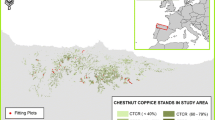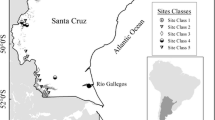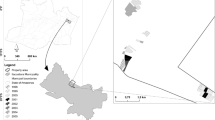Abstract
Site productivity, assessed through site index, was modelled using partial least squares regression as a function of soil and climatic variables. Two alternative models were developed: a full model, considering all available explanatory variables, and a reduced model, considering only variables that can be obtained without digging a soil pit. The reduced model was used for mapping the site index distribution in Portugal, on the basis of existing digital cartography available for the whole country. The developed models indicate the importance of water availability and soil water holding capacity for site index value distribution. Site index was related to climate, namely evaporation and frost, and soil characteristics such as lithology, soil texture, soil depth, thickness of the A horizon and soil classification. The variability of the estimated values within the map (9.5–16.8 m with an average value of 13.4 m) reflects the impact of soil characteristics on the site productivity estimation. These variables should be taken into consideration during the establishment of new plantations of cork oak, and management of existing plantations. Results confirm the potential distribution of cork oak in coastal regions. They also suggest the existence of a considerable area, located both North and South of the Tagus river, where site indices values of medium (]13;15]) to high (]15;17]) productivity classes may be expected. The species is then expected to be able to have good productivity along the northern coastal areas of Portugal, where presently it is not a common species but where, according to historical records, it occurred until the middle of the sixteenth century. The present research focused on tree growth. Cork growth and cork quality distribution needs to be further researched through the establishment of long term experimental sites along the distribution area of cork oak, namely in the central and northern coastal areas of the country.




Similar content being viewed by others
References
Abdi H (2010) Partial least squares regression and projection on latent structure regression (PLS regression). Comput Stat 2:97–106
Aertsen W, Kinta V, van Orshovena J, Özkanb K, Muys B (2010) Comparison and ranking of different modelling techniques for prediction of site index in Mediterranean mountain forests. Ecol Model 221(8):1119–1130
AFN (2010) Inventário Florestal Nacional Portugal Continental IFN5, 2005–2006. Autoridade Florestal Nacional, Lisboa
Almeida A, Tomé M (2010) Field sampling of cork value before extraction in Portuguese ‘montados’. Agrofor Syst 79(3):419–430
Alves A, Santos A, Rozenberg P, Pâques LE, Charpentier J, Schwanninger M, Rodrigues J (2012) A common near infrared based partial least squares regression model for the prediction of wood density of Pinus pinaster and Larix X eurolepis. Wood Sci Technol 46:157–175
APA (1984) Carta Ecológica de Portugal—Atlas Digital de Portugal. Agencia Portuguesa do Ambiente, Lisboa. http://sniamb.apambiente.pt/webatlas/
Besson CK, Lobo-do-Vale R, Rodrigues ML, Almeida P, Herd A, Grant OM, David TS, Schmidt M, Otieno D, Keenan TF, Gouveia C, Mériaux C, Chaves MM, Pereira JS (2014) Cork oak physiological responses to manipulated water availability in a Mediterranean woodland. Agric For Meteorol 184:230–242. doi:10.1016/j.agrformet.2013.10.004
Bevan KJ, Kirkby MJ (1979) A physically based, variable contributing area model of basin hydrology. Hydrol Sci Bull Sci Hydrol 24:43–69
Bikindou FDA, Gomat HY, Deleporte P, Bouillet J, Moukini R, Mbedi Y, Ngouaka E, Brunet D, Sita S, Diazenza J, Vouidibio J, Mareschal L, Ranger J, Saint-André L (2012) Are NIR spectra useful for predicting site indices in sandy soils under Eucalyptus stands in Republic of Congo? For Ecol Manage 266:126–137
Bravo-Oviedo A, Montero G (2005) Site index in relation to edaphic variables in stone pine (Pinus pinea L.) stands in south west Spain. Ann For Sci 62:61–72
Bravo-Oviedo A, Río MD, Montero G (2004) Site index curves and growth model for Mediterranean maritime pine (Pinus pinaster Ait.) in Spain. For Ecol Manage 201:187–197. doi:10.1016/j.foreco.2004.06.031
Cardoso JC, Bessa MT, Marado MB (1973) Carta de solos de Portugal (1:1.000.000). Agron Lusit XXXIII(I–IV):481–602
Carrascal LM, Galván I, Gordo O (2009) Partial least squares regression as an alternative to current regression methods used in ecology. Oikos 118(5):681–690
Cheng-liang L, Cun-yong J, Ti-jiu C, Xia J, Xiao-hua W, Xuc-ying D (2012) Estimating canopy closure density and above-ground tree biomass using partial least square methods in Chinese boreal forests. J For Res 23(2):191–196
Clutter JL, Fortson JC, Pienaar LV, Brister GH, Bailey RL (1983) Timber management: a quantitative approach. Krieger, Florida
Coelho MB, Paulo JA, Palma JHN, Tomé M (2012) Contribution of cork oak plantations installed after 1990 in Portugal to the Kyoto commitments and to the landowners economy. For Policy Econ 17:59–68
Corona P, Scotti R, Tarchiani N (1998) Relationship between environmental factors and site index in Douglas-fir plantations in central Italy. For Ecol Manage 110:195–207
Correia AV, Oliveira AC (2003) Principais espécies florestais com interesse para Portugal. Ministério da Agricultura, Desenvolvimento Rural e Pescas - Direcção Geral das Florestas, Lisboa
Costa LF (1997) Naus e galeões na ribeira de Lisboa. A construção naval no século XVI para a rota do cabo. Patrimonia – Associação de Projectos Culturais e Formação Turística, Cascais
Costa A, Madeira M, Oliveira AC (2008) The relationship between cork oak growth patterns and soil, slope and drainage, in a cork oak woodland in Southern Portugal. For Ecol Manage 255:1525–1535
David TS, Henriques MO, Kurz-Besson C, Nunes J, Valente F, Vaz M, Pereira JS, Siegwolf R, Chaves MM, Gazarini LC, David JS (2007) Water-use strategies in two co-occurring Mediterranean evergreen oaks: surviving the summer drought. Tree Physiol 27(6):793–803. doi:10.1093/treephys/27.6.793
Davison AC, Hinkley DV (1997) Bootstrap methods and their application. Cambridge series in statistical and probabilistic mathematics. Cambridge University Press, Cambridge
De Martonne E (1925) Traite de Geographie Physique, vol 1. Paris, pp 1925–1927
Fisher RF, Binkley D (2000) Ecology and management of forest soils, 3rd edn. Wiley, New York
Fontes L, Tomé M, Thompson F, Yeomans A, Luís JS, Savill P (2003) Modelling the Douglas-fir (Pseudotsuga menziesii (Mirb.) Franco) site index from site factors in Portugal. Forestry 76:491–507
Gea-Izquierdo G, Cañellas I, Montero G (2008) Site index in agroforestry systems: age-dependent and age-independent dynamic diameter growth models for Quercus ilex in Iberian open oak woodlands. Can J For Res 38(1):101–113
Geladi P, Kowalski B (1986) Partial least squares regression: a tutorial. Anal Chim Acta 185:1–17
Hidalgo PJ, Marín JM, Quijada J, Moreira JM (2008) A spatial distribution model of cork oak (Quercus suber) in Southern Spain: a suitable tool for reforestation. For Ecol Manage 255:25–34
IUSS Working Group WRB (2006) World reference base for soil resources 2006, 2nd edn. World Soil Resources reports no. 103, FAO, Rome
Jarvis A, Reuter HI, Nelson A, Guevara E (2008) Hole-filled SRTM for the globe, Version 4. CGIAR–CSI SRTM 90m Database. International Center for Tropical Agriculture, Cali, Columbia. http://srtm.csi.cgiar.org
Lacambra LCJ, Andray AB, Francés FS (2010) Influence of soil water holding capacity on the potential distribution of forest species. A case study: the potential distribution of cork oak (Quercus suber L.) in central-western Spain. Eur J For Res 129:111–117
McKenney DW, Pedlar JH (2003) Spatial models of site index based on climate and soil properties for two boreal tree species in Ontario, Canada. For Ecol Manage 175:497–507
Miranda P, Coelho FES, Tomé AR, Valente MA, Carvalho A, Pires C, Pires HO, Pires VC, Ramalho C (2002) 20th century Portuguese climate and climate scenarios. In: Santos FD, Forbes K, Moita R (eds) Climate change in Portugal. Scenarios, impacts and adaptation measures—SIAM Project. Gradiva Publishers, Lisbon, pp 23–83
Myers RH (1990) Classical and modern regression with applications, 2nd edn. Duxbury classic series. Pacific Grove, California, p 357
Palmer DJ, Hock BK, Kimberley MO, Watt MS, Lowe DJ, Payn TW (2009) Comparison of spatial prediction techniques for developing Pinus radiate productivity surfaces across New Zealand. For Ecol Manage 258:2046–2055
Paulo JA, Palma JHN, Tomé M (2013) Impact of forest policies to promote plantation and tree density increase in cork oak stands for future cork availability. The 3rd International Congress on Planted Forests. 16th to 21st May 2013. http://www.efiatlantic.efi.int/portal/events/past_events/2013/icpf/scientific_workshops/porto__portugal/
Sánchez-González M, Tomé M, Montero G (2005) Modelling height and diameter growth of dominant cork oak trees in Spain. Ann For Sci 62:633–643
Sánchez-González M, Río M, Cañellas I, Montero G (2006) Distance independent tree diameter growth model for cork oak stands. For Ecol Manage 225:262–270
SAS Institute Inc. (2000) SAS/STAT user’s guide: version 8, vol 1–3. SAS Institute Inc., Cary
Silva AMS (1983) Carta Litológica/Notícia Explicativa (I.13) de Portugal. Atlas do Ambiente. Comissão Nacional do Ambiente, Lisboa. http://sniamb.apambiente.pt/webatlas/
Sorensen R, Zinko U, Seibert J (2005) On the calculation of the topographic wetness index: evaluation of different methods on field observations. Hydrol Earth Syst Sci Dis 2:1807–1834
Tomé M (2005) Demonstração da gestão do montado de sobro apoiada em inventário florestal e modelos de crescimento e produção. PROJECTO AGRO no 81. Relatório Final – Relatório de Execução Material (Volume I). Publicações GIMREF RFP 1/2005. Universidade Técnica de Lisboa. Instituto Superior Agronomia. Centro de Estudos Florestais, Lisboa. http://hdl.handle.net/10400.5/1845
Tomé J, Tomé M, Barreiro S, Paulo JA (2006) Age-independent difference equations for modelling tree and stand growth. Can J For Res 36:1621–1630
van der Voet H (1994) Comparing the predictive accuracy of models using a simple randomization test. Chemom Intell Lab Syst 25:313–323
Vessella F, Schirone B (2013) Predicting potential distribution of Quercus suber in Italy based on ecological niche models: conservation insights and reforestation involvements. For Ecol Manage 304:150–161
Wold S (1994) PLS for multivariate linear modeling. QSAR: chemometric methods in molecular design. In: van de Waterbeemd H (ed) Methods and principles in medicinal chemistry. Verlag-Chemie, Weinheim, pp 195–218
Acknowledgments
This work was supported by Fundação para a Ciência e a Tecnologia (Portugal) under contracts SFRH/BD/23855/2005 and SFRH/BPD/96475/2013, and under projects CarbWoodCork (POCI/AGR/57279/2004 and PPCDT/AGR/57279/2004) and Pest-OE/AGR/UI0239/2011. Support was also given by EU projects MOTIVE (Grant Agreement 226544) and StarTree (Grant Agreement 311919), both financed under the Seventh Framework Program for Research and Technological Development. Authors acknowledge the collaboration in data collection from: Associação de Produtores Florestais do Concelho de Coruche e Limítrofes (APFC), Associação dos Agricultores de Charneca (ACHAR), Associação dos Produtores Florestais de Ponte de Sôr (AFLOSOR), Associação de Produtores Florestais do Vale do Sado (ANSUB), Câmara Municipal de Barrancos, Empresa Municipal Herdade da Contenda, Câmara Municipal de Alfândega da Fé. Authors acknowledge manuscript revision made by Dr. Jo Smith.
Author information
Authors and Affiliations
Corresponding author
Rights and permissions
About this article
Cite this article
Paulo, J.A., Palma, J.H.N., Gomes, A.A. et al. Predicting site index from climate and soil variables for cork oak (Quercus suber L.) stands in Portugal. New Forests 46, 293–307 (2015). https://doi.org/10.1007/s11056-014-9462-4
Received:
Accepted:
Published:
Issue Date:
DOI: https://doi.org/10.1007/s11056-014-9462-4




